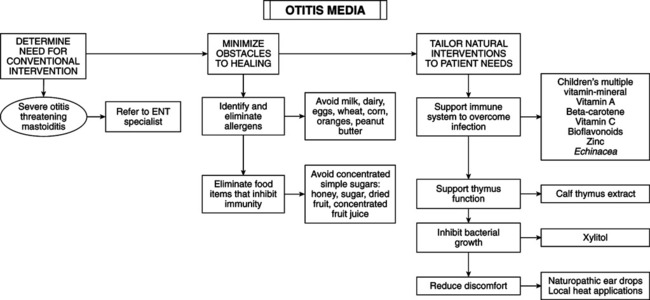• Acute OM: usually preceded by upper respiratory tract infection or allergy. Common microorganisms are Streptococcus pneumoniae (40%) and Haemophilus influenzae (25%). • Chronic OM (also known as serous, secretory, or nonsuppurative OM, chronic OM with effusion; or “glue ear”): constant swelling of middle ear. Acute OM affects two thirds of American children by age 2 years; chronic OM affects two thirds of children younger than 6 years. OM is the most common diagnosis in children and accounts for >50% of all visits to pediatricians. Eight billion dollars are spent annually on medical and surgical treatment. • Interventions: antibiotics, analgesics (e.g., acetaminophen), and/or antihistamines. If longstanding infection is unresponsive to drugs, surgery is performed that involves placing a tiny plastic myringotomy tube through the eardrum to drain fluid into the throat by the eustachian tube. • Children with tubes in their ears are more likely to have further problems with OM. Surgery is unnecessary for most children. Only 42% of these surgeries are judged appropriate. No significant differences in clinical course of acute OM have been found between conventional treatments and placebo. No differences have been found between nonantibiotic treatment, ear tubes, ear tubes with antibiotics, and antibiotics alone. Children not receiving antibiotics may have fewer recurrences than those receiving antibiotics because of immune suppression and disturbance of respiratory microflora by antibiotics. • Results of recent international review: antibiotics are not recommended for OM in most children. Conventional alternative: analgesics (e.g., acetaminophen) and close observation by parent; 80% of children with acute OM respond to placebo within 48 hours. A natural alternative to avoid analgesic toxicity are botanical ear drops (see below). • Risks of antibiotics: allergic reactions, gastric upset, accelerated bacterial resistance, unfavorable changes in nasopharyngeal bacterial flora. Antibiotics fail to eradicate microbe, may induce middle ear superinfection, and increase return office visits. Concurrent antibiotic and steroid treatment yields poor results. • Antibiotics induce chronic candidiasis and “superbugs” resistant to antibiotics. They should be used only for underlying systemic infection. • OM is normally self-limiting. Eighty percent of children’s cases spontaneously remit within 2-14 days; children younger than 2 years have a lower spontaneous resolution of 30% after a few days. • Evaluate each child individually. Follow up: devise physician-family communication before making a decision not to use conventional medicine. • Special circumstances to prevent hearing loss–induced developmental delays suggest use of ear tubes. • Pneumococcal and viral vaccines have little benefit because of the multifactorial nature of OM. With risks and complications, vaccinations are warranted at this time for the prevention of otitis media.
Otitis Media
GENERAL CONSIDERATIONS
Standard Medical Treatment

![]()
Stay updated, free articles. Join our Telegram channel

Full access? Get Clinical Tree


Otitis Media
